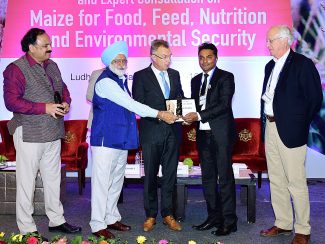
Dinesh Panday, a UNL agronomy graduate student in soil fertility and nutrient management, was presented as one of the winners of the Maize-Asia Youth Innovator Awards in Ludhiana, India on October 10, 2018. Panday conducts research in the Scottsbluff area on nitrogen fertilizer impacts.
“It was my honor to represent the University of Nebraska-Lincoln as well as my home country, Nepal, in such a glorious event,” Panday said.
At the closing plenary session of the the 13th Asian Maize Conference from October 8-10, Panday was invited to present his work in maize research for development. His research aims to determine the effectiveness of high-carbon char in reducing environmental nitrogen loss and improving nitrogen fertilizer use efficiency in fertilized soils in semi-arid regions, based on his work at the Panhandle Research and Extension Center. The project uses sensors to detect maize nitrogen stress, predict grain yield and determine in-season and additional side-dress applications of nitrogen fertilizer, to reduce environmental impacts.
His advisors are Bijesh Maharjan, assistant professor of agronomy and horticulture and Soils and Nutrient Management Specialist at the Center, and Richard Ferguson, professor and interim head of the Department of Agronomy and Horticulture.
“I feel privileged to receive this award and it has encouraged me to work more on maize-based agri-food system. I am very thankful to my advisor, Dr. Maharjan, for providing me continuous support and encouragement to grow professionally.”
The 2018 Maize-Asia Youth Innovators Awards recognize the contributions of innovative young women and men who can inspire fellow young people to get involved with maize-based research, change agency and farming. The awards aim to celebrate youth participation in maize-based agri-food systems and are sponsored by the Consultative Group on International Agricultural Research Program on Maize (CGIAR MAIZE) in collaboration with Young Professionals for Agricultural Development (YPARD).
Click here to view the original article published by the UNL Department of Agronomy and Horticulture.